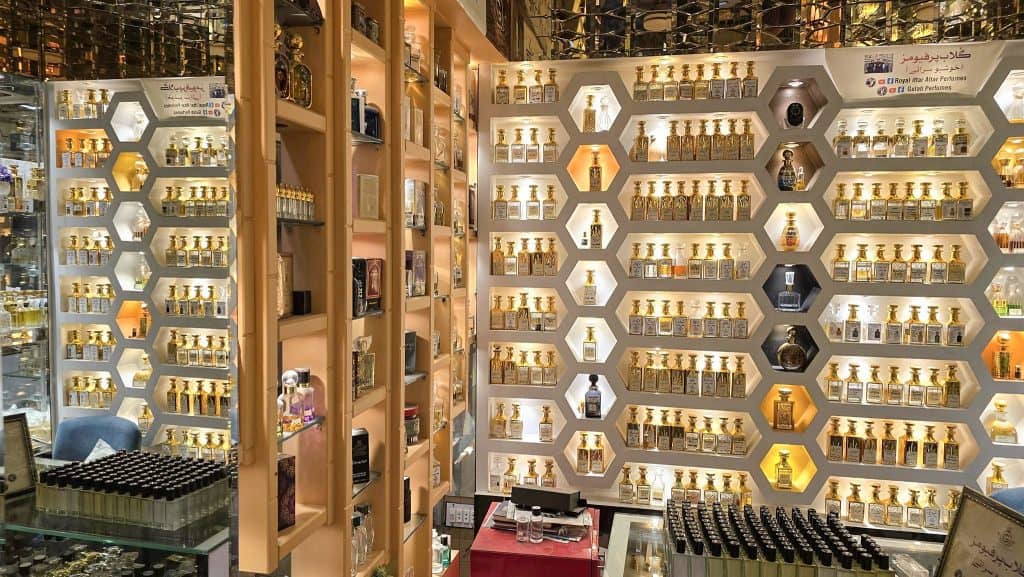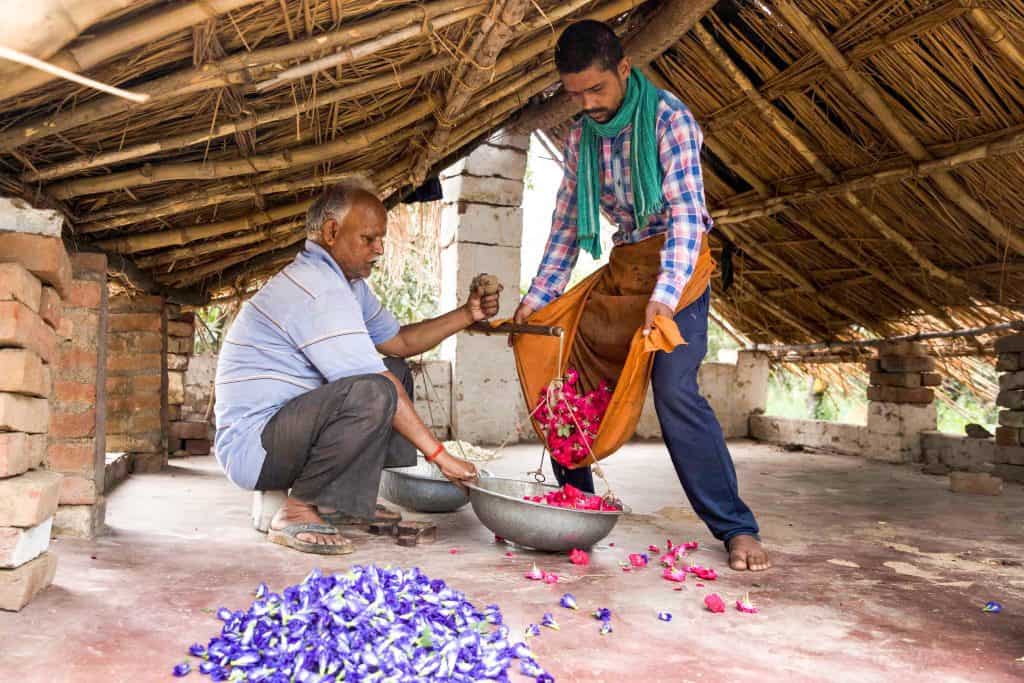The captivating journey of Ittar, India’s ancient perfumery art, is a fine art where tradition and craftsmanship intertwine to create fragrances that capture the essence of heritage.

In the realm of fragrances, where modern perfumery often seeks the cutting edge of innovation, there exists a timeless tradition that harks back to an era where scents were not just a mere accessory but a part of the cultural fabric and personal identity.
This is the world of Ittar, also known as Attar, a type of traditional perfume extracted from flowers, herbs, and spices, which has been cherished for centuries for its natural, enduring essence. Unlike contemporary fragrances that rely heavily on synthetic components, Ittar is crafted through a meticulous, ancient process that distils the very soul of nature into a form that can be worn and cherished.
The legacy of Ittar is as rich and diverse as the cultures that have nurtured it. Originating from the ancient lands of Persia, Ittar found its way into the Indian subcontinent, the Middle East, and beyond, weaving its aromatic presence into the rituals, traditions, and daily lives of countless generations.
This art, passed down through generations, symbolizes more than just the mastery of perfume making; it embodies the connection between humanity and the natural world, a testament to the human desire to capture and hold onto the ephemeral beauty of nature.
We delve into the heart of Ittar, exploring its historical journey, the traditional methods of its creation, and the unique place it holds in the heritage of various cultures. From the bazaars of Istanbul to the flower fields of Kannauj in India, we trace the footprint of this ancient art, uncovering the stories and secrets that have kept it alive through millennia.
The fine art of making Ittar and its enduring legacy
The words attar ittar concentrated perfume oil originates from an old Persian term that meant “perfume, aroma, or smell.” This word was pronounced “attar,” “Otto,” or “Ottar.” The process of distilling fragrance from flowers, herbs, and other sources of botanical origin is an essential step in the production of attar fragrance oils. Several of the oils used to make attar are derived from various types of wood.
Ittar making is considered an art form due to the deep knowledge, patience, and skill required to extract the essence of plant material and transform it into a concentrated, fragrant oil. The process begins with the careful selection of raw materials, which are then cleaned and prepared for distillation.
Historically, it was used for personal adornment, medicinal purposes, and in religious practices. It was also a symbol of hospitality, with hosts often offering Ittar to guests as a sign of respect and welcome. Today, while the popularity of synthetic fragrances has grown, there remains a dedicated niche of aficionados who appreciate the natural beauty and heritage of traditional perfumery.
The art of making Ittar, with its rich history and cultural significance, continues to enchant and inspire, offering a fragrant link to the past and a testament to the enduring appeal of natural perfumes.
Let’s explore the wide history and the making process of the aromatic Ittar.
History Whispers The Story of Ittar
The people who lived in the Indus Valley Civilisation were the first to produce attars. This civilization was one of the three great cradles of civilization, along with ancient Egypt and Mesopotamia. Culturally and historically, the people who lived in an area that included the majority of what is now Pakistan and India are considered to have been Indians.

These early civilizations were among the first to distil and produce attar. Even though the name ittar was eventually adopted by the civilizations of Persia and Arab countries, its roots remain firmly anchored in the taxonomy and culture of India.
The Mughal Empire, a Turco-Mongol monarchy that existed in India and was culturally Persian, was responsible for propelling the production of attar to the forefront of worldwide significance in 1526. Passionate about scent, the Mughal emperors and princes supervised the blossoming of a golden period of ittar-making that survived the Mughal Empire itself, which came to an end more than three centuries later in 1857.
At the end of the day, even though the custom of manufacturing attars is deeply rooted in Indian culture, it was the influence of the Persian culture of the Mughal Empire that led to the expansion of ittar-making beyond the boundaries of India herself.
Since the Mughal rulers lavished power and fame on the local Indian attar producers, they are credited with bringing about a golden period in the history of ittar production.
Alchemy of Aroma: The Fine Art of Ittar
Elites of the Mughal dynasty in India were among the first consumers of essential oils. After the Mughal monarchy fell into disarray in the 18th century, the Nawabs took control of Awadh and established themselves as its new rulers. It is said that the late Nawab Wajid Ali Shah was a talented Kathak dancer.
During the time of the Nawab, the arts and crafts community in Lucknow, the capital of India’s Awadh region, thrived. It is reported that he worked up a lot of sweat while practising his dance, which is why he would put the henna attar. Awadh was instrumental in advancing agricultural practices and Ittar handicrafts, both of which have persisted to the present day.
Traditionally making an Ittar requires a great deal of expertise and information, and as Indians have been doing so for more than five thousand years, they are the undisputed leaders in this field. Kannauj, which is located in the Indian state of Uttar Pradesh and serves as the state capital, is widely regarded as the birthplace of the art of ittar production.
Ittar manufacturers in Kannauj have a long history of dealing with Middle Eastern countries and have provided ittars to the princes of the Mughal Empire for more than three centuries. Kannauj is appropriately referred to as the Grasse of the Ittar World because it is bordered by silt-rich fields and valleys that support the growth of an astonishing variety of exotic flowers, scented grasses, roses, and herbs.
Traditional deg – Copper stills, sometimes known as degs, are used throughout the process. Since the dawn of time, degs have been an essential component in the production of organic fragrance oils via the use of time-honoured methods. Copper metal is used to construct degs, which also have an aperture that may accommodate connections to either one or two recipients.
Bhapka or Receiver – Copper is used in the construction of the Bhapka, which has a spherical form and a long neck. It is also known as a “receiver.” The receiver is expected to maintain a connection with the deg via the use of chonga while the attar is being crafted. In the regional language, it is known as bhapka, and it also performs the function of a condenser.
Bhatti or Furnace – Bricks and clay are often utilised in the construction of traditional bhatti, which ittar artisans use. During the procedure, wood or coal is most often used to heat the environment.
Gachchi – The Bhapka, also known as the receiver, is stored in a chilled water tank, and the tank’s job is to cool the distillate down to a temperature of.
Kuppi – Kuppi is a leather bottle manufactured in the traditional way in Japan. Ittars may be dehumidified in these bottles using the appropriate method.
Resins and gums are two examples of substances that can’t be extracted by the use of steam or water but may be used in the production of ittars. When this occurs, the substance is heated until it generates fluid tears. These fluid tears are scraped from the inside of the warmed deg and then combined with sandalwood oil. After that, the attars are powdered, cleaned, preserved, and developed in the same manner as conventional floral ittars.
It is said that certain civilizations have held the belief that ittars had the power to fend off bad spirits while also attracting angels. This belief dates back thousands of years. Saints and other spiritual seekers used to decorate themselves with these fragrances so that they might progress more quickly down the path leading to enlightenment.
Offerings made in homes and temples are considered forms of devotion for the many sects that make up Hinduism. Ittars are often used inside the offerings of incense and food that are given to deities. This has been nature’s timeless gift to us from the natural world.
Where to buy
Small shops located all around India, as well as online retailers that focus only on the production of ittars, are good places to look for ittars to purchase. Despite this, the best spot to get ittar is in the Indian town of Kannauj, also known as the only town in India where attars are produced.
More than a fragrance
The journey from the ancient Indus Valley to the Mughal courts and beyond highlights Ittar’s rich tapestry woven through history, culture, and artistry. This aromatic legacy, deeply rooted in Indian soil yet influenced by Persian sophistication, showcases a blend of tradition and craftsmanship, marking Ittar as more than just a fragrance.
It embodies the essence of cultural heritage, the finesse of distillation art, and the timeless allure of nature’s scents. As Ittar continues to be celebrated and cherished in modern times, its story—a blend of history, culture, and skilled artistry—remains a testament to the enduring appeal of natural perfumes, bridging ancient wisdom with contemporary appreciation.
Read more: Latest



